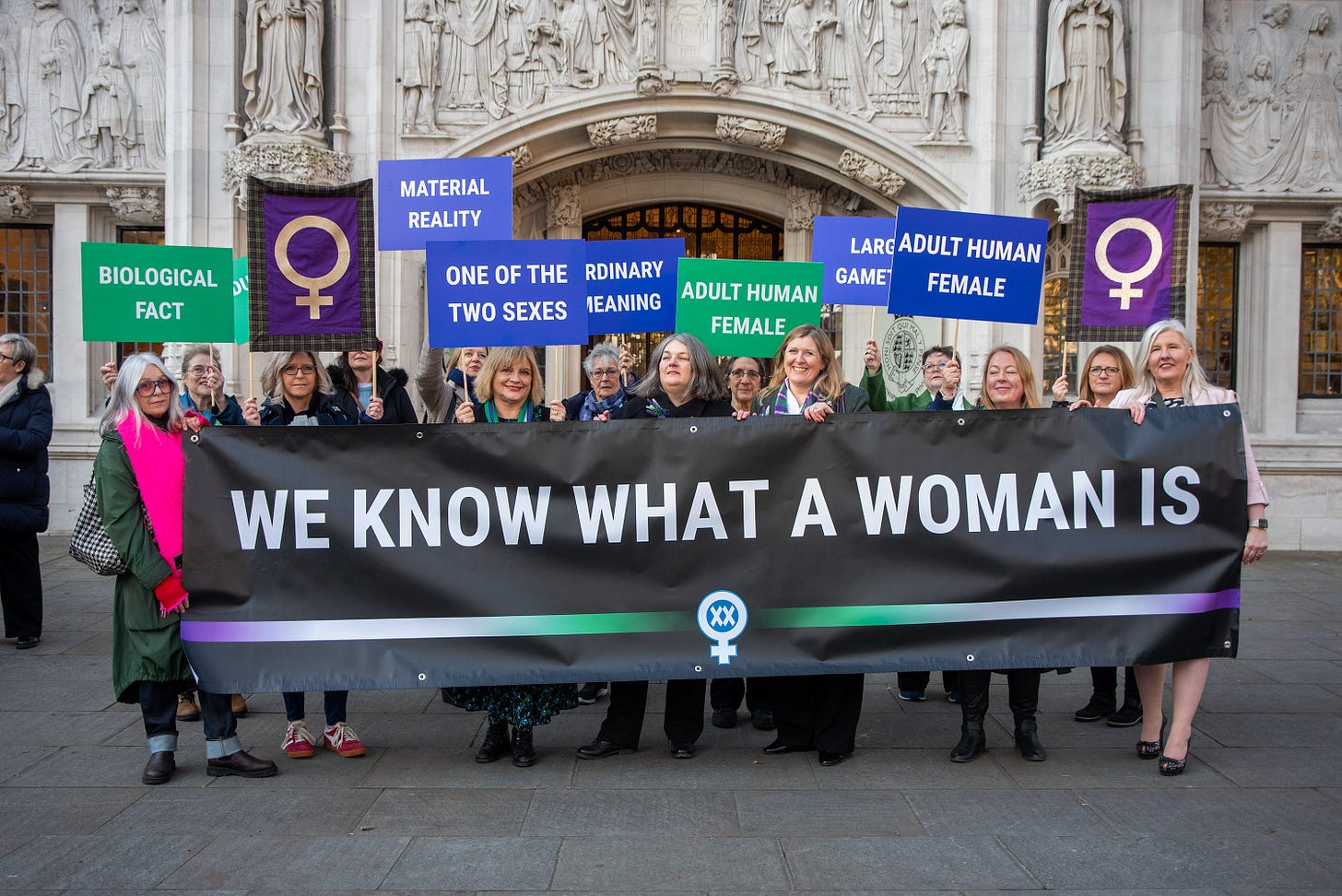FOR WOMEN SCOTLAND HAVE WON THEIR CASE, THE JUDGMENT HAVING JUST BEEN HANDED DOWN!!
🥳 🎉 🎈
THE (VERY LONG) JUDGMENT AND THE PRESS SUMMARY ARE HERE.
https://www.supremecourt.uk/cases/uksc-2024-0042
Paragraph 265 of the judgment provides a summary of the meaning of ‘sex’ in the Equality Act:
265. We are aware that this is a long judgment. It may assist therefore if we summarise our reasoning.
(i) The question for the court is a question of statutory interpretation; we are concerned with the meaning of the provisions of the EA 2010 in the light of section 9 of the GRA (para 2).
(ii) Parliament in using the words “man” and “woman” in the SDA 1975 referred to biological sex (paras 36-51).
(iii) The 1999 Regulations, enacted in response to P v S, created a new protected characteristic of a person intending to undergo, or undergoing or having undergone gender reassignment. The 1999 Regulations did not amend the meaning of “man” or “woman” in the SDA 1975 (paras 54-62).
(iv) The GRA 2004 did not amend the meaning of “man” and “woman” in the SDA 1975 (para 80).
(v) Section 9(3) of the GRA 2004 disapplies the rule in section 9(1) of that Act where the words of legislation, enacted before or after the commencement of the GRA 2004, are on careful consideration interpreted in their context and having regard to their purpose to be inconsistent with that rule. It is not necessary that there are express words disapplying the rule in section 9(1) of the GRA 2004 or that such disapplication arises by necessary implication as the legality principle does not apply (paras 99-104).
(vi) The context in which the EA 2010 was enacted was therefore that the SDA 1975 definitions of “man” and “woman” referred to biological sex and trans people had the protected characteristic of gender reassignment.
(vii) The EA 2010 is an amending and consolidating statute. It enacts groupbased protections against discrimination on the grounds of sex and gender reassignment and imposes duties of positive action (paras 113, 142-149).
(viii) It is important that the EA 2010 is interpreted in a clear and consistent way so that groups which share a protected characteristic can be identified by those on whom the Act imposes obligations so that they can perform those obligations in a practical way (paras 151-154).
(ix) There is no indication in relevant secondary materials that the EA 2010 modified in any material way the meaning of “man” and “woman” or “sex” from the meanings in the SDA 1975 (para 164).
(x) Interpreting “sex” as certificated sex would cut across the definitions of “man” and “woman” and thus the protected characteristic of sex in an incoherent way. It would create heterogeneous groupings. As a matter of ordinary language, the provisions relating to sex discrimination, and especially those relating to pregnancy and maternity (sections 13(6), 17 and 18), and to protection from risks specifically affecting women (Schedule 22, paragraph 2), can only be interpreted as referring to biological sex (paras 172, 177-188).
(xi) We reject the suggestion of the Inner House that the words can bear a variable meaning so that in the provisions relating to pregnancy and maternity the EA 2010 is referring to biological sex only, while elsewhere it refers to certificated sex as well (paras 189-197).
(xii) Gender reassignment and sex are separate bases for discrimination and inequality. The interpretation favoured by the EHRC and the Scottish Ministers would create two sub-groups within those who share the protected characteristic of gender reassignment, giving trans persons who possess a GRC greater rights than those who do not. Those seeking to perform their obligations under the Act would have no obvious means of distinguishing between the two sub-groups to whom different duties were owed, particularly since they could not ask persons whether they had obtained a GRC (paras 198-203).
(xiii) That interpretation would also seriously weaken the protections given to those with the protected characteristic of sexual orientation for example by interfering with their ability to have lesbian-only spaces and associations (paras 204-209).
(xiv) There are other provisions whose proper functioning requires a biological interpretation of “sex”. These include separate spaces and single-sex services (including changing rooms, hostels and medical services), communal accommodation and others (paras 210-228).
(xv) Similar incoherence and impracticability arise in the operations of provisions relating to single-sex characteristic associations and charities, women’s fair participation in sport, the operation of the public sector equality duty, and the armed forces (paras 229-246).
(xvi) It is striking that the EHRC has advised the UK Government of the problems created by its interpretation of the EA 2010, which include many of the matters which we have discussed above, and has called for legislation to amend the Act. The absence of coherence and the practical problems to which that interpretation gives rise are clear pointers that the interpretation is not correct (para 247).
(xvii) The interpretation of the EA 2010 (ie the biological sex reading), which we conclude is the only correct one, does not cause disadvantage to trans people, with or without a GRC. In the light of case law interpreting the relevant provisions, they would be able to invoke the provisions on direct discrimination and harassment, and indirect discrimination. A certificated sex reading is not required to give them those protections (paras 248-263).
(xviii) We therefore conclude that the provisions of the EA 2010 which we have discussed are provisions to which section 9(3) of the GRA 2004 applies. The meaning of the terms “sex”, “man” and “woman” in the EA 2010 is biological and not certificated sex. Any other interpretation would render the EA 2010 incoherent and impracticable to operate (para 264).
Andrew Doyle has got off the blocks ahead of me on his substack!! I hope he will forgive me for quoting all of his excellent piece:
The supreme court knows what a woman is
The landmark decision has been announced; reality has prevailed.
Apr 16, 2025
If the law is an ass, the culture war is a bigger one. How else can one explain the phenomenon of judges at the UK supreme court gathering to determine the definition of a ‘woman’? This landmark case was heard in November, and today the verdict has been reached: ‘The unanimous decision of this court is that the terms woman and sex in the Equality Act 2010 refer to a biological woman and biological sex’.
So there we have it. We now have confirmation that a person’s sex does not change under the Equality Act simply because he or she holds a Gender Recognition Certificate (GRC). It is curious to think that this decision could have gone either way. When the Equality Act was penned fifteen years ago, not a single legal mind in the land would have entertained the notion that its references to ‘sex’ and ‘women’ would one day cause confusion. Surely these most unambiguous of terms could not have been open to challenge?
The casual observer might have assumed that the judiciary has gone mad, but there are good reasons why this case was raised. It has come about because of the Scottish government’s view – enshrined in its guidance on the Gender Representation on Public Boards (Scotland) Act 2018 – that ‘sex’ in the Equality Act refers to ‘gender identity’ rather than, you know, an individual’s potential to produce large or small gametes. From the SNP’s perspective, anyone could be a woman so long as they hold a GRC. But this legal fiction – created in the Gender Recognition Act of 2004 – has created problems, not least that some of those so certificated now seem to believe that this should grant them access to women-only spaces.
The court’s decision could never have altered reality, of course. Human beings cannot change sex, no matter what the law says. The legal fiction of ‘gender’ has emboldened various campaign groups over the years to rewrite the law inside their own heads, which is why Stonewall was found to have been representing the law as it ‘would prefer it to be, rather than the law as it is’. As a result of this activist meddling, many organisations and even schools have been operating under the assumption that anyone who claims to be female should have access to women’s toilets and changing areas, but this has never been the case. Nor has it even been true that self-identification exists in law, in spite of claims to the contrary by genderists.
For Women Scotland was able to make this challenge because the Scottish government has a duty to comply with the Equality Act in its guidance and legislation. By arguing that a GRC could make a man a woman for the purposes of the 2018 Act, they were effectively prohibiting women from assembling without men. This is a scenario that has already been playing out in Australia, where lesbians are no longer permitted to hold female-only events, because to exclude any man who believes himself to be a woman would be illegal discrimination. In the recent case of Sall Grover, we even had a judge ruling that ‘sex is changeable’. Reader: it isn’t.
For those in any doubt at the absurdity of this debate, here is an excerpt from the submission by Scottish Lesbians, The Lesbian Project and LGB Alliance:
‘It barely needs stating that lesbians are females who are sexually orientated to the bodies of other females. Again, it barely needs stating that there are anatomical differences between males and females. The defining characteristic of a lesbian is that she is not sexually attracted to male bodies, including penises, testicles, male body mass and shape. Nor is she sexually attracted to certificates.’
Anyone seriously attempting to argue against this is irretrievably detached from reality.
The task of the supreme court was interpretative, and their interpretations of the Gender Recognition Act and the Equality Act should settle many of the more frustrating debates of our times. Ultimately, that we have reached this point at all tells us all we need to know about the careening lunacy of the culture wars. Such has been the power of activists that they have been able to reduce the judiciary to a laughing stock. Their war on women has also been a war on language and reality, and the fact that even the highest judges in the land have been dragooned into the fray is some indication of the extent of their power.
It is reassuring that the supreme court eventually settled on the side of reality, but this war will doubtless continue to rage. Activists have made clear that they consider the law an enemy, and this ruling will not change that. In this most deranging of times, it is worth reiterating the basic facts. No human being has ever changed sex. Men cannot become women and women cannot become men. Trans women are, by definition, male. Trans men are, by definition, female. There is no such thing as a ‘trans child’. ‘Non-binary’ is a fashionable form of self-classification, not an inherent characteristic worthy of protection in law. These are facts that will not bend according to the whims of those who wish to run roughshod over the rights of women and gay people.
Men who wave their GRCs around like magic wands and believe that it transforms them into lesbians are deluded. Thank goodness the judges understood this incontestable truth.
Here is EDI Jester:
I will do a summary of reports from people later.
CONGRATULATIONS TO FOR WOMEN SCOTLAND AND EVERYONE WHO SUPPORTED THEM.
#BeMorePorcupine







Dear readers
My wife and I are going in to B'ham this afternoon to meet our Terf friends, Mark and Sue to celebrate.
I still hope to be back later with a follow up report 😇
Enjoy today y'all
Dusty
This is such wonderful news!!!!!! thanks Dusty! A moment of joy for once!